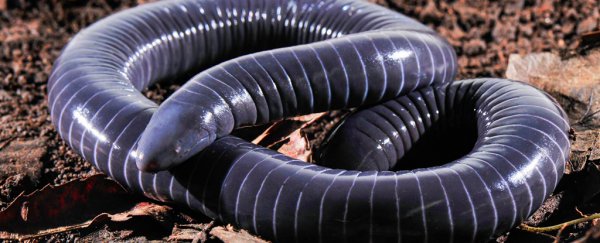Meet the caecilian: looking like a cross between a snake and a worm, these creatures have been around for hundreds of millions of years, but scientists just made a brand new discovery about them.
While caecilians are only distantly related to snakes, new research shows they appear to have similar venom glands. This is the first time such glands have been spotted in an amphibian, and it looks like they could even provide the animals with a dangerous bite.
If it's confirmed that these glands do indeed contain venom, then the caecilian becomes the oldest land-dwelling vertebrate animal with a venomous bite, a secret that it has kept hidden for several millennia.
"These animals produce two types of secretions – one is found mostly in the tail that is poisonous, while the head produces a mucus to help with crawling through the earth," says biologist Carlos Jared, from the Butantan Institute in Brazil.
"Because caecilians are one of the least-studied vertebrates, their biology is a black box full of surprises."
Biologist Pedro Luiz Mailho-Fontana from the Butantan Institute, first author of the new study, found the tell-tale glands in an examination of a dead ringed caecilian (Siphonops annulatus). Microscopic analysis showed that these glands originated not from the epidermis, like the poisonous skin glands of the caecilian, but from dental tissue.
That matches how venom glands in snakes are connected, though it's never been seen before in amphibians – suddenly making the caecilian something of a biological celebrity.
 Upper jaw with teeth and related glands [usually beneath skin]. (Carlos Jared)
Upper jaw with teeth and related glands [usually beneath skin]. (Carlos Jared)
While the proteins in the gland fluid match up with what you would expect to find in venom, we're still waiting for confirmation of exactly what the fluid contains, and how many caecilian species (of which there are over 200) share these characteristics.
The researchers already have some ideas about how a venomous bite could be used, however.
"Since caecilians have no arms or legs, the mouth is the only tool they have to hunt," says evolutionary biologist Marta Maria Antoniazzi, from the Butantan Institute.
"We believe they activate their oral glands the moment they bite down, and specialised biomolecules are incorporated into their secretions."
The findings aren't just important for the study of caecilians, but also for the much broader evolutionary picture – these underground amphibians have been around a lot longer than snakes have, which means they could well be the oldest animal around with a venomous bite.
Neither caecilians nor snakes have many weapons in their armoury – not having any actual feet or arms – and so it's possible that the evolution of a venomous snap is somehow related to being limbless, across both amphibians and reptiles.
Now the team wants to capture and examine more caecilians, but considering their slippery nature and their tendency to spend most of the time burrowing underground, that's not going to be easy.
Eventually, scientists should be able to learn much more about how these venom glands developed.
"Unlike snakes which have few glands with a large bank of venom, the ringed caecilian has many small glands with minor amounts of fluid," says Jared.
"Perhaps caecilians represent a more primitive form of venom gland evolution. Snakes appeared in the Cretaceous probably 100 million years ago, but caecilians are far older, being roughly 250 million years old."
The research has been published in iScience.
